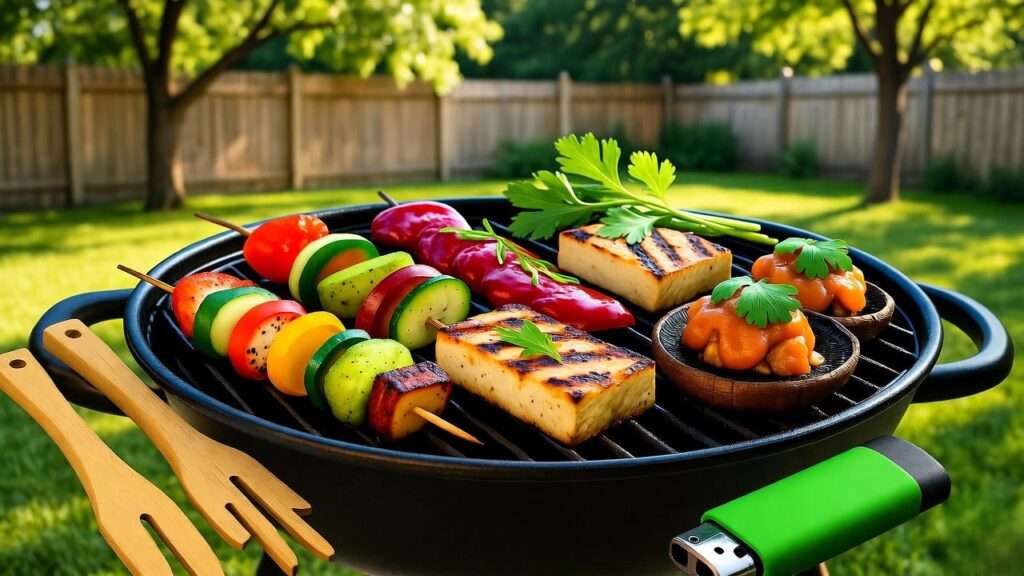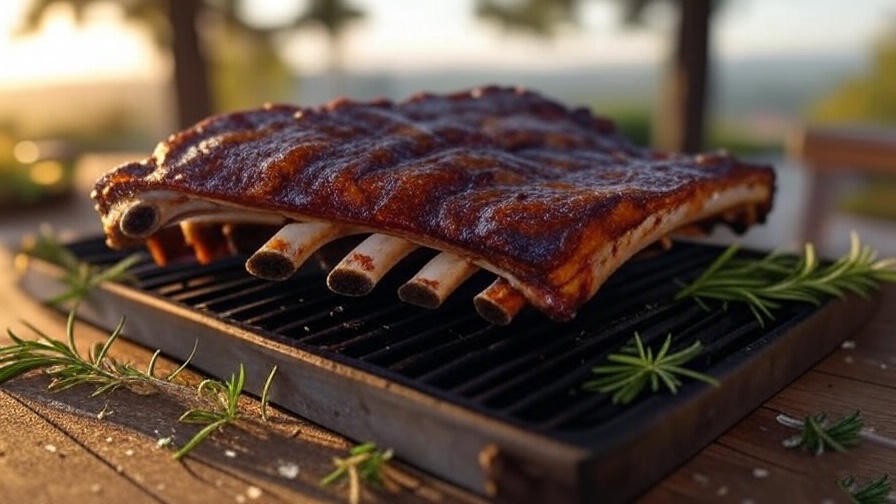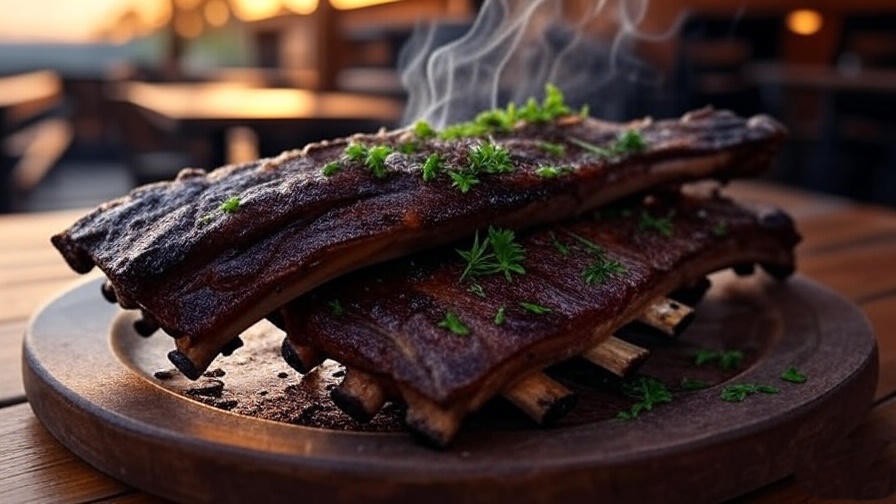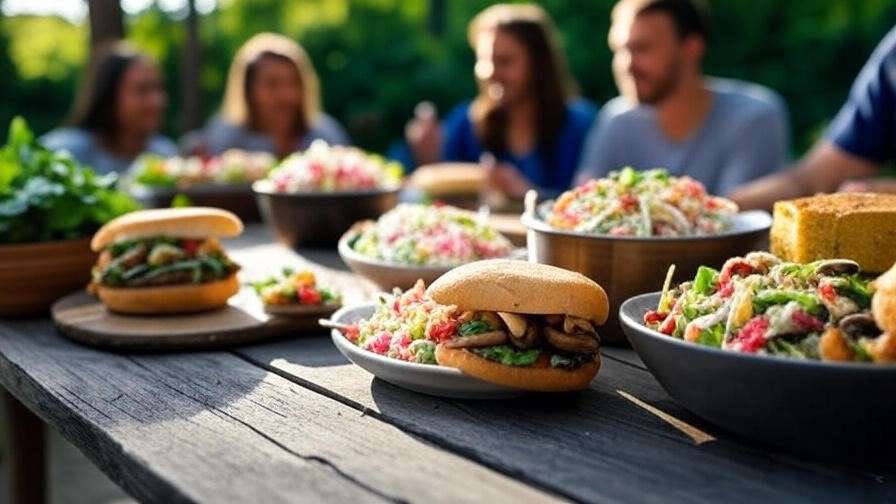Imagine the sizzle of vibrant veggies on the grill, the laughter of friends and family gathered around, and the satisfaction of knowing your feast is both delicious and kind to the planet. Hosting a plant-based BBQ buffet doesn’t have to be daunting—it’s an opportunity to create memorable, inclusive gatherings that cater to diverse tastes while promoting health and sustainability. Whether you’re a seasoned vegan or just exploring plant-based options, this ultimate guide equips you with everything needed to orchestrate a flawless BBQ buffet. From menu ideas to eco-friendly tips, we’ll cover it all, ensuring your event stands out as a beacon of mindful entertaining.
Why Host a Plant-Based BBQ Buffet?
Benefits for Health and Environment
Embracing a plant-based BBQ buffet offers profound health advantages. According to the American Heart Association, consuming more plant-based foods can decrease the risk of heart disease, stroke, obesity, high blood pressure, high cholesterol, type 2 diabetes, and many cancers.
These diets emphasize nutrient-dense foods like fruits, vegetables, whole grains, and legumes, which provide essential vitamins, minerals, and fiber often lacking in meat-heavy meals. For instance, a study published in the Journal of the American Heart Association found that higher adherence to a healthy plant-based diet index was associated with a 19% lower risk of cardiovascular disease mortality.
On the environmental front, plant-based eating significantly reduces your ecological footprint. The United Nations highlights that shifting to more plant-based foods promotes better health and lowers environmental impact by using less land, producing fewer greenhouse gases, and requiring less water.
Food production accounts for over a third of global greenhouse gas emissions, with animal agriculture being a major contributor.
By opting for a plant-based BBQ buffet, you’re not just feeding your guests—you’re contributing to planetary health, addressing the urgent need for sustainable food systems in an era of climate change.
Rising Demand for Plant-Based Options
The demand for plant-based foods is skyrocketing, making a BBQ buffet an ideal way to meet modern dietary preferences. In 2024, plant-based food sales reached $8.1 billion, with 59% of U.S. households purchasing these products.
The Plant Based Foods Association reports robust growth, with dollar sales increasing by 20% in the last year, topping $3.3 billion as of mid-2025.
This surge reflects a broader shift toward flexitarian, vegetarian, and vegan lifestyles, driven by health, ethical, and environmental concerns.
Hosting a plant-based BBQ buffet solves the common problem of dietary exclusion at social events. Many guests face challenges finding suitable options, leading to discomfort or limited enjoyment. By centering your menu on plant-based delights, you create an inclusive space where everyone can indulge without compromise, fostering stronger connections and memorable experiences.
Expert Insight
As Dr. Lena Patel, a plant-based dietitian with 15 years of experience, notes: “A well-planned plant-based BBQ buffet not only nourishes the body but also aligns with sustainable living, making it a powerful tool for community wellness and environmental stewardship.”
Planning Your Plant-Based BBQ Buffet
Setting Goals and Budget
Begin by defining your BBQ buffet’s goals: Is it a casual family gathering or a large neighborhood event? Clarify the number of guests—aim for 10-20 for intimate affairs or up to 50 for bigger bashes—to guide your planning. Set a realistic budget, allocating about 40% to food, 20% to tools and decor, and the rest to contingencies.
Cost-saving strategies include buying seasonal produce in bulk from local markets, which reduces expenses while ensuring freshness. For example, summer staples like corn, tomatoes, and zucchini are often affordable and abundant. Use apps like GoodBudget to track spending, ensuring your plant-based BBQ stays economical without sacrificing quality.
Choosing the Right Date and Venue
Select a date during peak grilling season, such as late spring through early fall, to leverage warm weather. Check forecasts a week in advance and have a rain plan. Venues like backyards offer intimacy, while parks provide space for larger groups—ensure permits if needed.
For setup, prioritize shaded areas to keep food fresh and guests comfortable. Arrange seating in conversational clusters, and include stations for self-serve drinks to enhance flow. This thoughtful planning addresses the need for a seamless, enjoyable experience, turning potential stressors into smooth operations.
Creating an Inclusive Guest List
Invite a diverse mix of guests, considering dietary needs like gluten-free or nut allergies. Use digital tools like Evite to send invitations, including a note: “Join us for a plant-based BBQ buffet featuring delicious grilled veggies and more—let us know any dietary preferences!” This proactive approach ensures everyone feels welcome, solving the issue of overlooked needs in group events.
Essential Tools and Equipment for a Plant-Based BBQ Buffet
Must-Have Grilling Tools
A successful plant-based BBQ buffet requires reliable tools. Start with a high-quality grill—gas for convenience or charcoal for smoky flavor, opting for eco-friendly models. Essential items include long-handled tongs, spatulas, and bamboo skewers for veggie kebabs. Choose stainless steel or bamboo for sustainability, avoiding plastic that can melt or leach chemicals.
Safety is paramount: Invest in heat-resistant gloves and a grill brush for cleaning. For plant-based grilling, a veggie basket prevents small items from falling through grates, ensuring even cooking and presentation.
Sustainable Serving Solutions
Go green with compostable plates made from bamboo or sugarcane, reducing waste compared to disposables. Reusable melamine or glassware suits frequent hosts, while cloth napkins add elegance. For buffet setup, use tiered stands to display dishes attractively, keeping hot items on warming trays.
Expert Tip
To prevent cross-contamination, dedicate separate tools for plant-based items if any non-vegan elements are present. Regular grill cleaning with a natural brush maintains hygiene and flavor integrity.
Crafting a Delicious Plant-Based BBQ Menu
Appetizers and Starters
Kick off your BBQ buffet with enticing appetizers that set a flavorful tone. A grilled veggie platter featuring marinated zucchini slices, bell pepper strips, and portobello mushrooms offers a colorful, nutrient-packed start. Marinate in olive oil, balsamic vinegar, garlic, and herbs for 30 minutes, then grill for 5-7 minutes per side.
For a crowd-pleaser, try stuffed mini bell peppers: Hollow out halves, fill with a mix of quinoa, black beans, corn, and vegan cheese, then grill until charred. These bites provide protein and fiber, addressing the need for satisfying, handheld options at gatherings.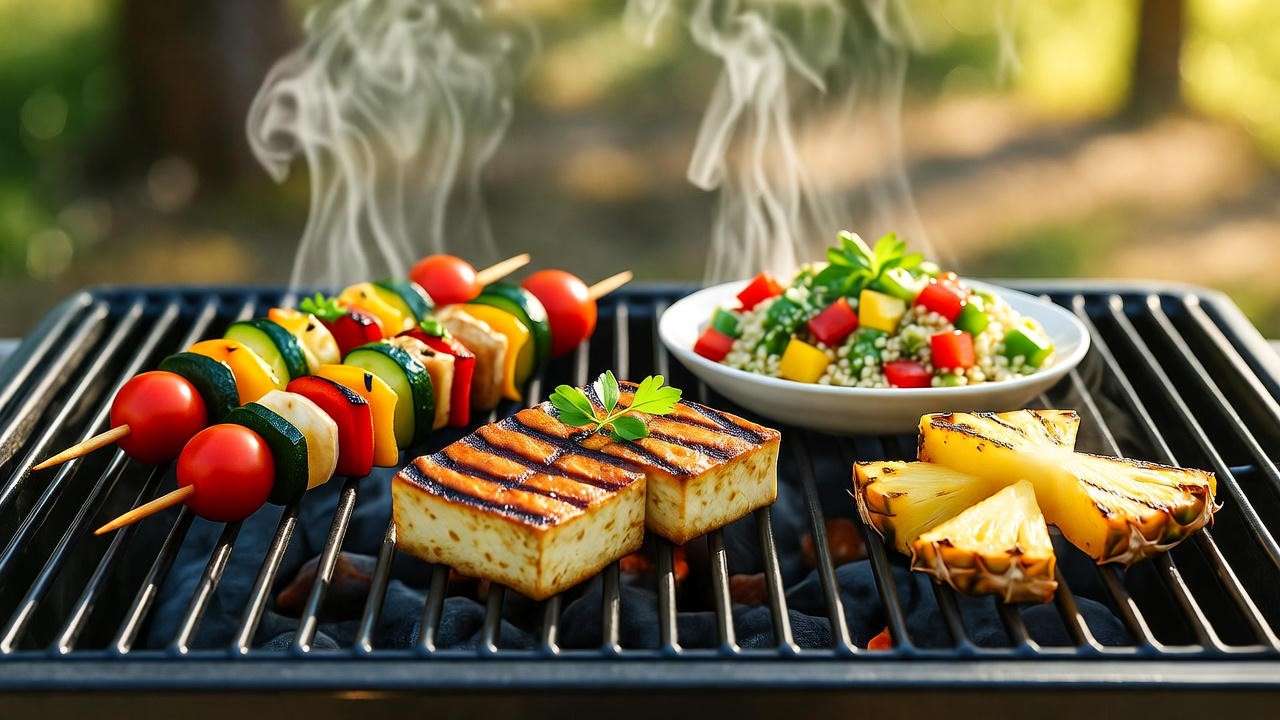
Main Dishes
The heart of your plant-based BBQ buffet lies in mains that mimic traditional favorites. Portobello mushroom burgers are a staple: Marinate caps in soy sauce, maple syrup, and smoked paprika, grill for 4-5 minutes per side, and serve on whole-grain buns with toppings like avocado and tomato. This recipe delivers umami without meat, appealing to all palates.
Grilled tofu skewers shine with firm tofu cubes marinated in ginger, sesame oil, and lime, threaded with onions, peppers, and cherry tomatoes. Grill for 10-12 minutes, rotating for even char. These provide 20g of protein per serving, solving the protein concern in plant-based diets.
Sides and Accompaniments
Complement mains with vibrant sides. A quinoa salad with cucumber, cherry tomatoes, feta-style vegan cheese, and a lemon-tahini dressing offers freshness and crunch. Roast potato wedges seasoned with rosemary and garlic for a hearty option—bake at 425°F for 25 minutes after parboiling.
Incorporate LSI terms like “vegan side dishes” naturally: These vegan side dishes enhance the BBQ buffet’s variety, ensuring balanced nutrition.
Desserts
End sweetly with grilled fruit skewers: Thread pineapple, peaches, and strawberries, brush with a agave-lime glaze, and grill for 2-3 minutes. Pair with coconut yogurt parfaits layered with granola and berries for a refreshing treat. These desserts are light yet indulgent, aligning with health-conscious plant-based eating.
Menu Planning Tips
Aim for balance: Include proteins (tofu, legumes), carbs (quinoa, potatoes), and veggies. Prepare a make-ahead checklist—marinate overnight, chop veggies in advance—to reduce day-of stress. Scale recipes: For 20 guests, plan 1.5 servings per person to account for seconds.
Sustainable Practices for Your BBQ Buffet
Sourcing Ingredients Locally
Local sourcing minimizes emissions and supports farmers. Visit markets for organic produce, reducing pesticide exposure and transport carbon. Community Supported Agriculture (CSA) boxes provide weekly deliveries, ensuring fresh, seasonal items for your BBQ buffet.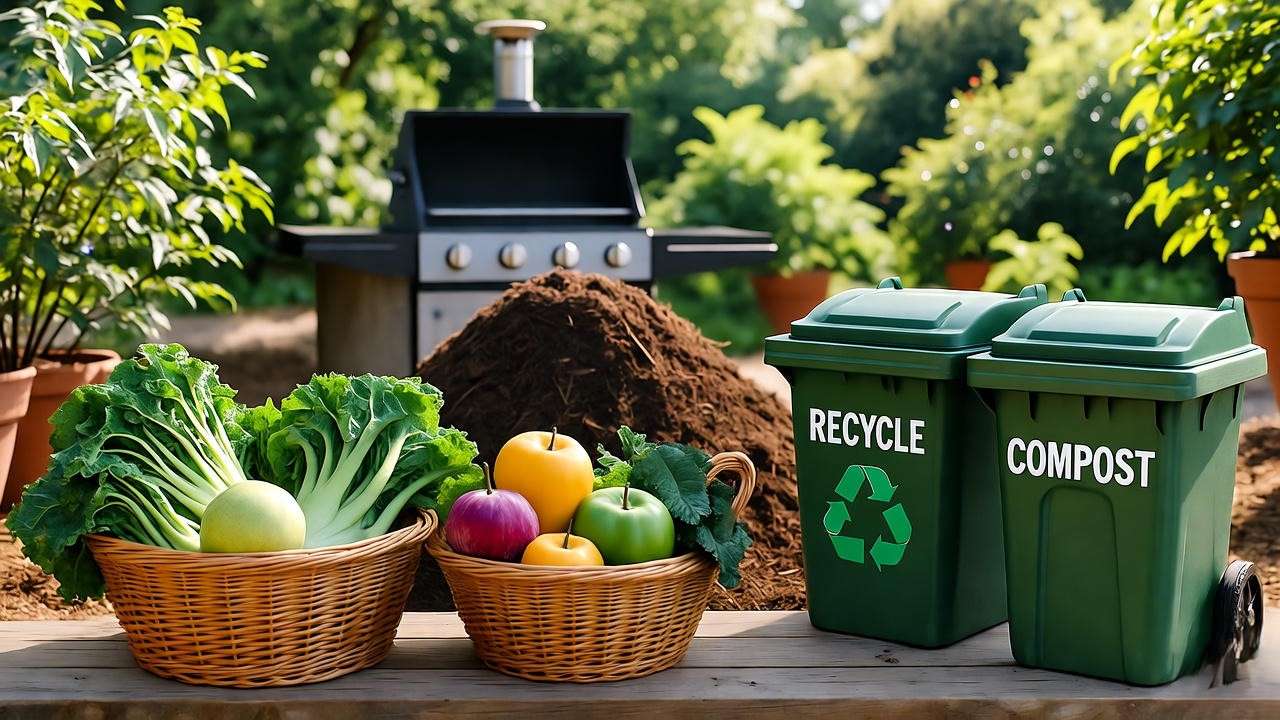
Minimizing Waste
Implement zero-waste strategies: Compost scraps using a backyard bin, and recycle packaging. Use portion control to avoid leftovers, or encourage guests to take home extras in reusable containers.
Eco-Friendly Decor and Cleanup
Decorate with potted herbs or wildflowers for natural appeal. For cleanup, use biodegradable wipes and eco-soap. A post-event plan includes sorting waste and donating unused food, reinforcing your commitment to sustainability.
Step-by-Step Guide to Hosting the Event
Pre-Event Preparation
Preparation is key to a seamless BBQ buffet. Start two weeks ahead by finalizing your guest list and sending invitations. One week out, shop for non-perishables like spices and serveware, then purchase fresh produce three days before, aligning with local market days. On the day prior, marinate proteins, chop veggies, and set up the grill area with a safety checklist: fire extinguisher, first-aid kit, and shaded seating.
Create a timeline: Begin grilling at 3:00 PM for a 5:00 PM start, allowing buffer time. This structured approach addresses the common pain point of last-minute chaos, ensuring a relaxed host experience.
During the Event
As guests arrive, welcome them with a self-serve drink station featuring infused water or iced herbal tea. Manage the grill in shifts—assign a friend to rotate skewers every 5 minutes—keeping mains warm on a tray. Set up a DIY skewer station with prepped veggies and tofu, encouraging participation and solving the issue of guest engagement.
Monitor buffet flow: Replenish dishes as needed and label items (e.g., “gluten-free quinoa salad”) to accommodate restrictions. This hands-on guidance turns hosting into a collaborative, enjoyable task.
Post-Event Wrap-Up
After the last guest departs, tackle cleanup promptly. Sort compost (veggie scraps), recycling (serveware), and donations (leftovers for shelters). Store perishables in airtight containers, and gather feedback via a quick survey: “What was your favorite dish?” This step addresses post-event fatigue, leaving you organized and informed for next time.
Overcoming Common Challenges
Handling Guest Dietary Restrictions
Dietary diversity is a strength, not a hurdle. Label each dish with ingredients and allergens—use chalkboard signs for charm. Offer alternatives like gluten-free wraps or nut-free dips. Adjust recipes: Swap soy sauce for tamari in marinades to accommodate gluten sensitivities. This inclusivity solves the problem of guest dissatisfaction, enhancing your reputation as a thoughtful host.
Managing Weather Issues
Weather can disrupt plans, but preparation mitigates risks. For rain, set up a tent or move indoors, pre-arranging a backup space. In heat, provide hydration stations with lemon-infused water and place food under shade. A backup plan—grilling indoors with a stovetop grill—ensures continuity, addressing the need for adaptability.
Expert Insight
Event planner Sarah Nguyen, with a decade in outdoor catering, advises: “Always have a weather contingency and clear communication with guests. A flexible mindset turns challenges into opportunities for creativity.”
FAQs About Hosting a Plant-Based BBQ Buffet
- Is a plant-based BBQ buffet suitable for non-vegans? Yes, the variety of flavors—smoky mushrooms, spiced tofu—appeals to all, with familiar textures mimicking meat dishes.
- How much food should I prepare per guest? Plan 1.5 servings per person for mains, 1 cup of sides, and half a cup of dessert, adjusting for appetites.
- Can I use the same grill for meat and plant-based items? Yes, but clean thoroughly with a wire brush and use separate tools to avoid cross-contamination.
- What are the best eco-friendly grilling fuels? Bamboo charcoal or electric grills offer sustainable, low-emission options for plant-based cooking.
- How do I keep food warm on a buffet table? Use chafing dishes with sterno fuel or electric warming trays, checking temperatures hourly (above 140°F).
Conclusion
Hosting a plant-based BBQ buffet is a rewarding way to nourish your community while championing sustainability. From planning your menu with grilled portobello burgers and quinoa salads to adopting eco-friendly practices like composting, this guide provides a roadmap to success. Try these ideas at your next gathering, share your favorite recipes in the comments, and stay tuned for advanced grilling techniques in our upcoming posts. Together, let’s make every BBQ a celebration of health, inclusivity, and planetary care.

